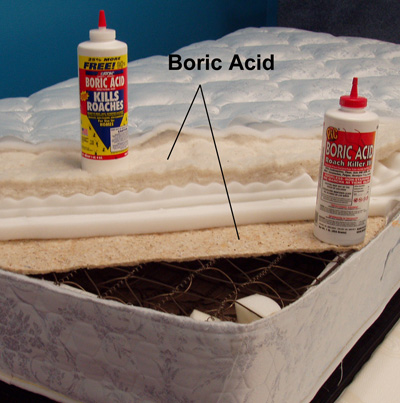|
The science of toxicology uses high dose short-term
exposure on various animals to predict the affect of low dose long-term exposure
on humans. Chemical exposure risk greatly increases with, close contact, and
length of exposure. For an infant born today this exposure on a mattress will be
eight or more hours per day, every day, for the next seventy years or more.
Boric Acid, a chemical made from the reaction of Sulfuric
Acid and Borax, should not be confused with Boron salts that occur in nature.
Boric acid is the raw stuff. It occurs in nature in only one place in the world
-- A steam vent in Italy where Sulfuric Acid mixes with Borax. (Microsoft
Encarta)

This mattress cutaway shows how Boric Acid is used in
mattresses. The layer at the surface is fluffy cotton batting treated with Boric
Acid. The layer next to the springs is compressed cotton batting treated with
Boric Acid. The law label tells us the mattress contains: 47% Urethane Foam,
39% Treated Cotton, 13% Polyester Fiber. By weighing the cotton batting in
the mattress and assuming 10% Boric Acid by weight, Boric Acid treated
mattresses would contain the following amount of Boric Acid in each mattress:
|
Size |
Pounds |
Ounces |
Grams |
Miligrams |
|
King |
1.8 |
29 |
824 |
824,000 |
|
Queen |
1.5 |
23 |
659 |
659,000 |
|
Full |
1.2 |
20 |
553 |
553,000 |
|
Twin |
0.9 |
14 |
386 |
386,000 |
Here is how Boric Acid is applied to cotton batting: “Generally
applied in the mixing machine prior to garneting, boric acid is introduced to
the cotton fibers along with a small amount of oil and chemical surfactant. To
further achieve even distribution and adherence to the fibers, the boric acid is
ground to a very fine consistency prior to application. … Applied as a white
powder, boric acid is inorganic and is odorless.” (NCBI) Thus you can see Boric
Acid is not chemically bound and exists as loose dust in the surface of our
mattresses. As the mattress gets older and oils dry out even more Boric Acid
will kick up into our faces with every body movement for us to breathe and
absorb.
Human fatal single dose of Boric Acid reported at 2 g. Children, 5 g. Adults.
There are already 6,453 US cases of Boric Acid Poisoning every year. Our
calculations show young children could be poisoned by sucking on boric acid
mattresses.
These mattresses also
contain Antimony. The CPSC extraction studies show cotton batting flame
proofing systems contain 2.4% Antimony. Based on cotton batting weights
measured above mattresses would contain the following amounts of Antimony:
Amount of Antimony in
Mattresses by Size
|
Size |
Pounds |
Ounces |
Grams |
Miligrams |
|
King |
0.43 |
7 |
198 |
197,760 |
|
Queen |
0.36 |
6 |
158 |
158,160 |
|
Full |
0.29 |
5 |
133 |
132,720 |
|
Twin |
0.22 |
3 |
93 |
92,640 |
Most government agencies
say there is no safe level of Antimony absorption.
By assuming, without
data, that we will absorb only 2/1,000's of Antimony and 9/100,000's of
Boric Acid, that has leached through our mattress and is in contact with our
bodies, the CPSC says we will absorb a daily dose of .802 mg Antimony and
.083 mg Boric Acid, every day for the rest of our lives. Of course, the
real number could be much higher. Many people don't want to absorb any
poison from their mattress and would rather take the one in one million
mattress fire risk.
|